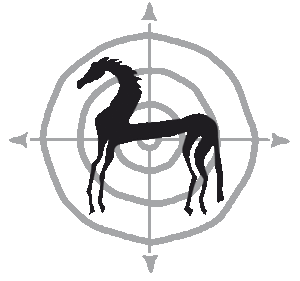
Question: What can barefoot horses do?
Answer: EVERYTHING!
‘Horses NEED shoes when they are working!’ That’s how I used to think….
But now I know better.
These days, horses all over the world are enjoying the benefits of barefoot.
All types of horses. In all climates. And in all types of riding and horse sports.
Here you can find just a few examples from our area.
A new scientific truth does not triumph by convincing its opponents and making them see the light, but rather because its opponents eventually die, and a new generation grows up that is familiar with it.
When you change the way you look at things, the things you look at change.
Max Planck, 1858-1947
Belgian Warmblood showjumping barefoot…
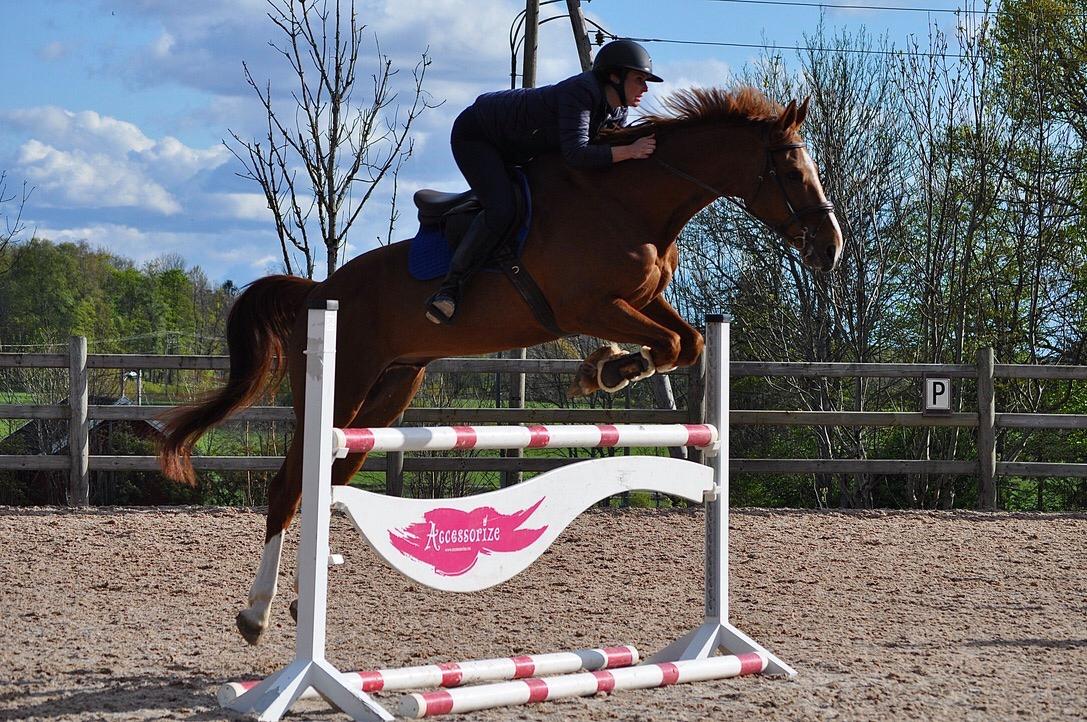
Sylvia Sørensen & Luca van het Bergeneinde (BWP)
Luca is a Belgian Warmblood born in 2011. Sylvia, his owner, found out after she purchased him, that he suffers from ‘shivering’. This is a neurological condition that usually affects the hindlegs. One of the symptoms is that it can be difficult for a horse with this condition to lift his hindlegs. Which can make it very hard to put shoes on…
Sylvia has chosen to keep Luca barefoot. They have progressed steadily and they are now training and competing at 1.20 level showjumping.
…and with his Norwegian Warmblood buddy in the mountains
This video shows Luca and his buddy Ciaran. Ciaran is a Norwegian Warmblood riding horse, born in 2002. He is also barefoot.
Here the boys have put on their ‘sneakers’ (horse boots) for a holiday trip in the Norwegian mountains! To be precise: in Rondane, the oldest national park in Norway.
A ‘sunny’ Welsh pony who does everything!
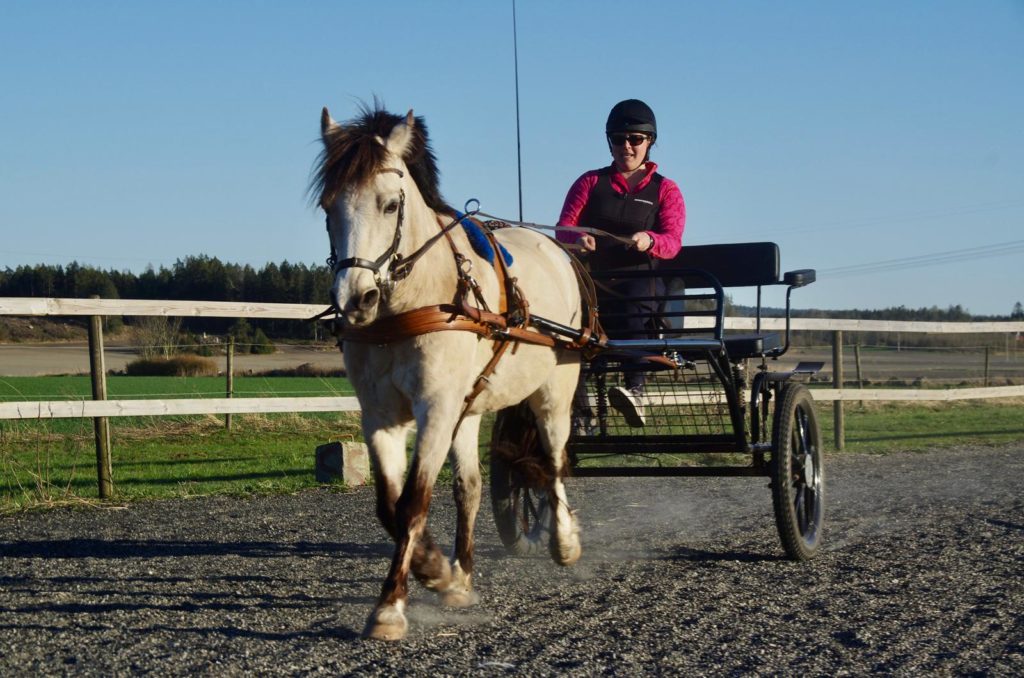
Sol showing off her paces while being driven by Siri Lund
Sol (Hasiella’s Sunlight) is a Welsh pony born in 2008. Her coat is a special yellowish colour, ‘dun’. And the name ‘Sol’ means sunlight in Norwegian.
In spite of being only 1.36 m, Sol is used for everything. Jumping, dressage, eventing, and just riding through the fields and woods. And now she is being trained for driving, too.
When it’s icy in winter Sol uses hoof boots with studs. Otherwise she goes barefoot in all disciplines and over all terrain.
Norwegian Warmblood: dressage, jumping and eventing barefoot
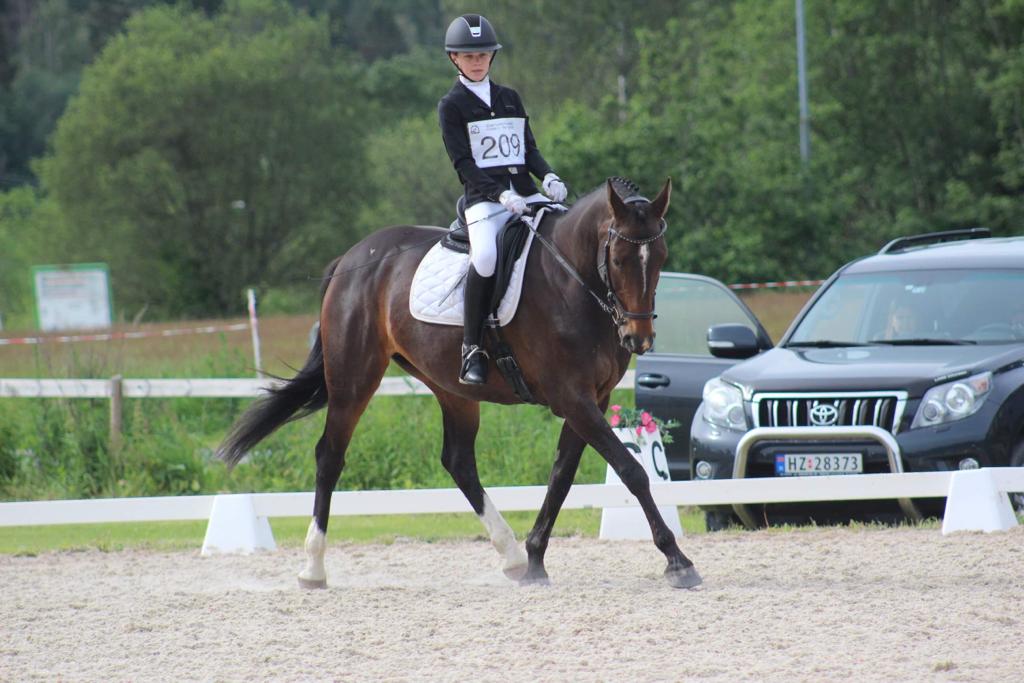
Ella doing a dressage test with her rider, Elise Lund Huseby
Performing well barefoot is not just for pony’s! Ella (Hasiella’s Dream) is a Norwegian Warmblood mare born in 2008. She has done all kinds of things with different riders. Eventing is one of them, and Ella has started up to 1* Event competitions.
Currently she is a schoolmaster for a younger rider, who uses her for both dressage, jumping, cross country and just having fun.
Ella does all of her work barefoot. However, if necessary she is shod. For example, if the cross country part of an event competition goes over very slippery terrain.
Indoor showjumping Norway 1.10 & 1.15
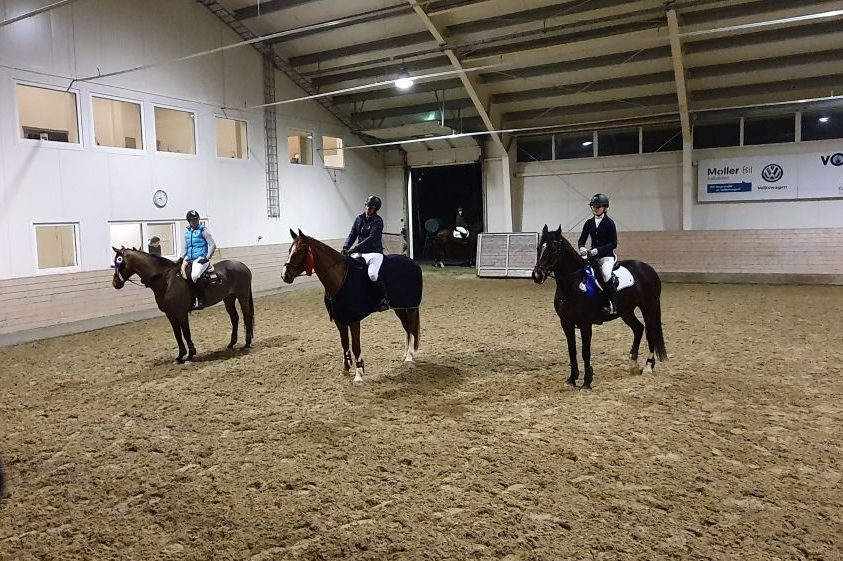
A 1.10 m showjumping class – 10 competitors – number 2 and 3 are barefoot.
Indoor showjumping competition in Norway, January 2020.
Height of this class was 1.10 m. There were 10 competitors – 2 of them with barefoot horses.
Luca van het Bergeneinde won 2nd place.
Another barefoot horse, Hasiellas Dream (‘Ella’), came in at 3rd place with her then 14 year old rider.
The next class (1.15) was won by Luca van het Bergeneinde!
Eventing training with Trakehner mare
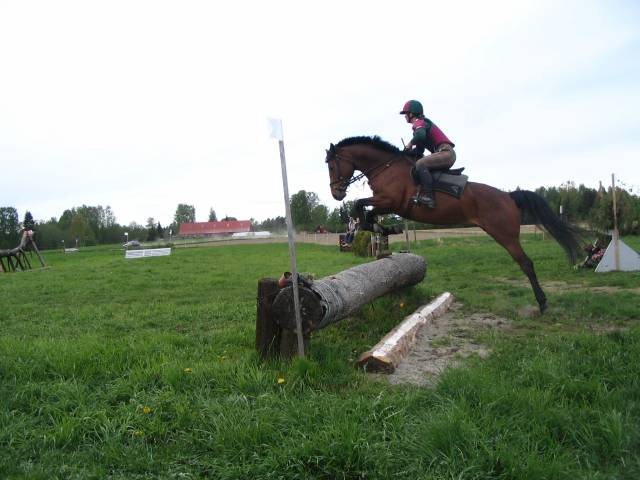
Kaia Steinberg and Nadya (NV) make it all look easy!
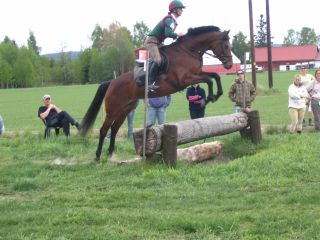
Energy to spare
Nadya is registered as a Norwegian Warmblood (NV). Her breeding, however, is pure Trakehner. She comes from some of the best-known Trakehner families.
The Trakehner Breeding Register only accepts crossings with Arabs and Thoroughbreds. Nadya is a prime example of this: both her father and her mother are 50% Thoroughbred.
This probably explains Nadya’s inexhaustable energy and her ‘eagle eye’!
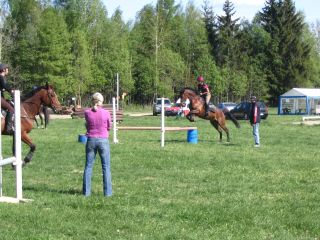
Lucinda Green watching Kaia and Nadya
These pictures are taken at a training with Lucinda Green. Lucinda is one of the worlds best eventing riders.
The Norwegian Riders Association had organized a training with Lucinda for the more experienced eventers in Norway.
Nadya performed very well and kept her footing, even on the slippery grass surface.
Thoroughbred with former bad hoof quality
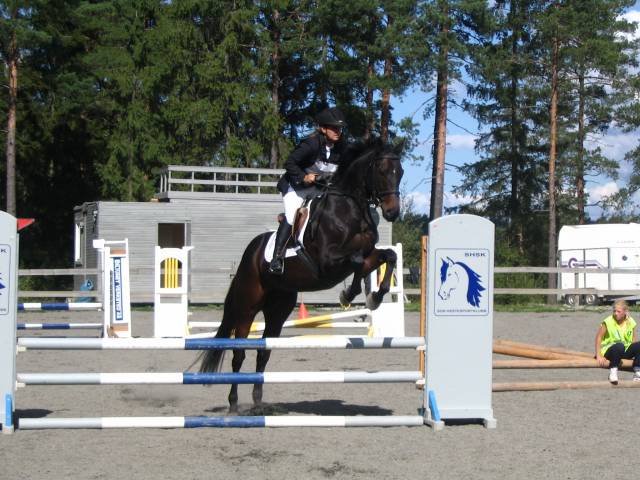
Kathrine Handal and Rhadagast XX – jumping barefoot during a one-day event
Rhadagast XX was a norwegian Thoroughbred, born in 1999. His owner purchased him to use for eventing.
There are many Thoroughbreds that have hoof problems. Often they have very flat feet with a tendency to underrun heels.
Which often makes it difficult to keep the shoes on – and not so easy to have them barefoot, either!
Hoof cracks
This also applied to Rhadagast XX. He used shoes from a young age and ended up with very bad hoof quality and substantial hoof cracks.
Ultimately it was tried to repair this by a partial hoof wall resection (taking part of the hoof wall off), artificial fillers and special shoes. That seemed to work while he was being stall-kept.
However, as soon as he was allowed out again, the whole repair fell apart.
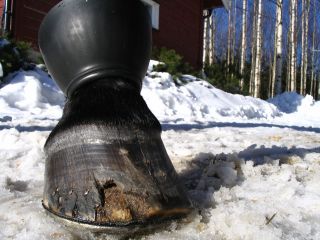
Rhadagast XX – Right front hoof, before (after attempted repair of cracks)
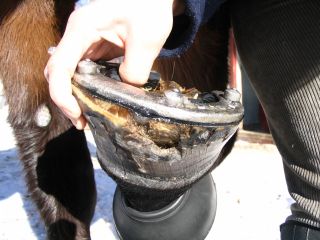
Rhadagast XX – Right front hoof, before (visible bad hoof wall connection/large hool in hoof wall)
The horse was not useable because of the hoof problems. Therefore it was decided to take his shoes off and give him the summer to recuperate.
He was sent to pasture and received regular hoof care there.
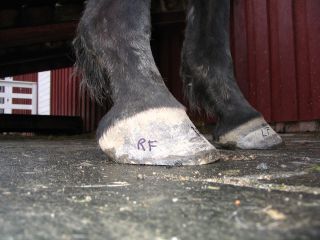
Rhadagast XX – Right front hoof, after
After the summer his rider started riding him again. Using hoof boots when necessary.
His training was gradually increased and this went very well.
He came back into full training as an event horse, and in later years as a hobby horse.
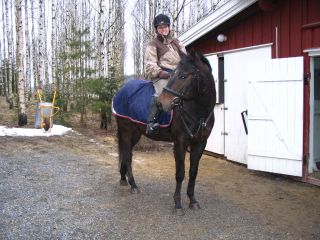
Rhadagast XX and rider, after a 3 hour ride – without hoof boots!
Note: ‘Going barefoot’ can work wonders in many cases. But it’s not enough to just take the shoes off! You have to think of many factors. Regular hoof care, nutrition, the surface the horse is used on, veterinary support, and so on. And you have to be prepared to use hoof boots when necessary.
So it’s far from a ‘quick fix’ (although it often gives results fairly quickly) or the cheapest solution. Although it can save costs in the long run. Especially if it keeps your horse healthier and useable.
Norwegian Fjord horse
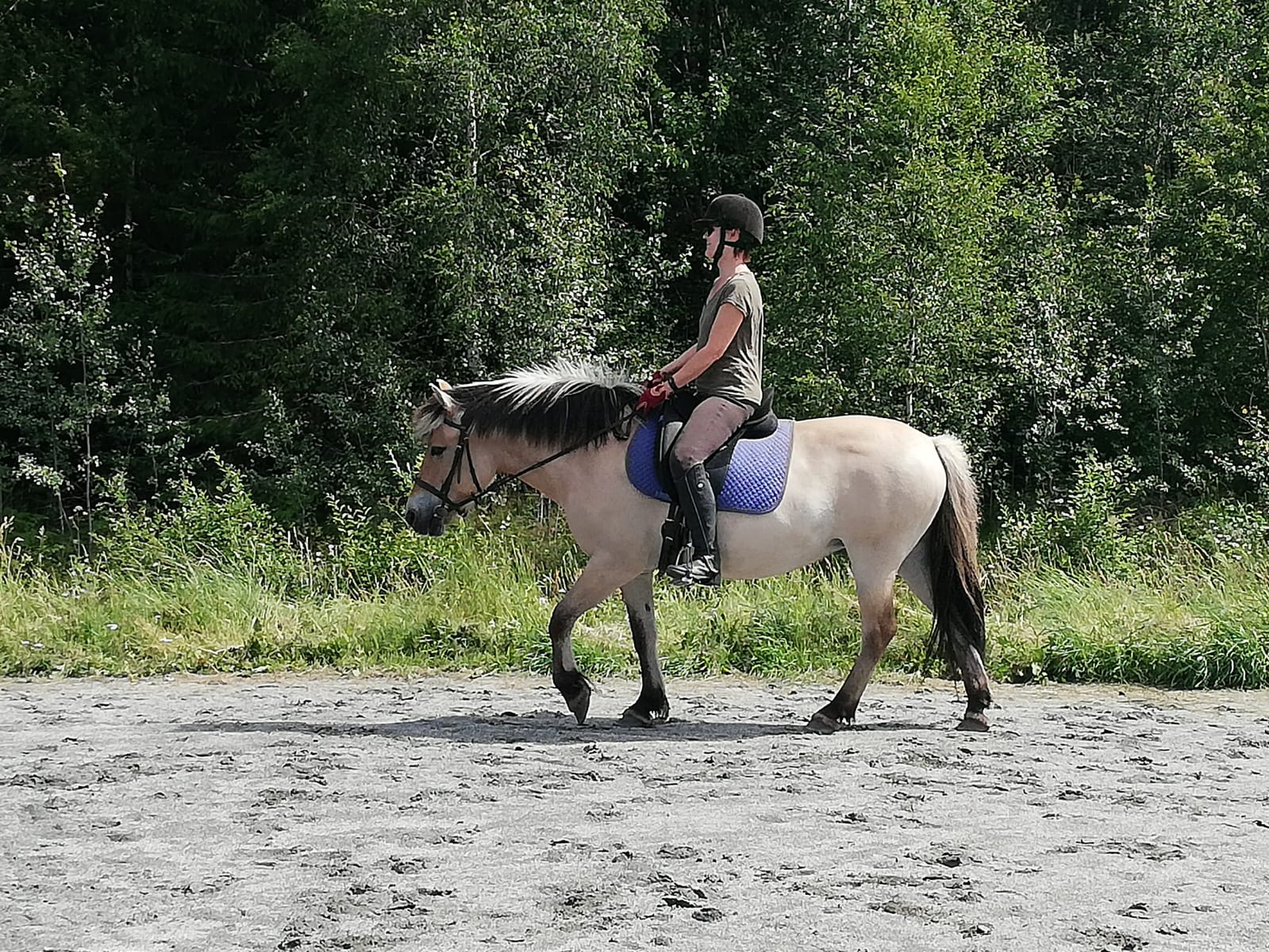
Fia and her rider going places!
Many people in Norway say that Fjord horses cannot be used without shoes. ‘Fjordinger’ can have fairly open hooves, with not too much height. And the climate does not always help. Ice and snow can be a challenge.
Fia is a Fjord horse born in 2004. She has a great work attitude and is very kind. Fia is sometimes being used for beginning riders and small children. And even for a disabled rider.
Mona Duaas, her owner, uses her mainly for countryside rides. Using ‘sneakers’ (hoof boots) when necessary. Fia uses hoof boots with studs when it’s slippery.
Danish Warmblood dressage horse
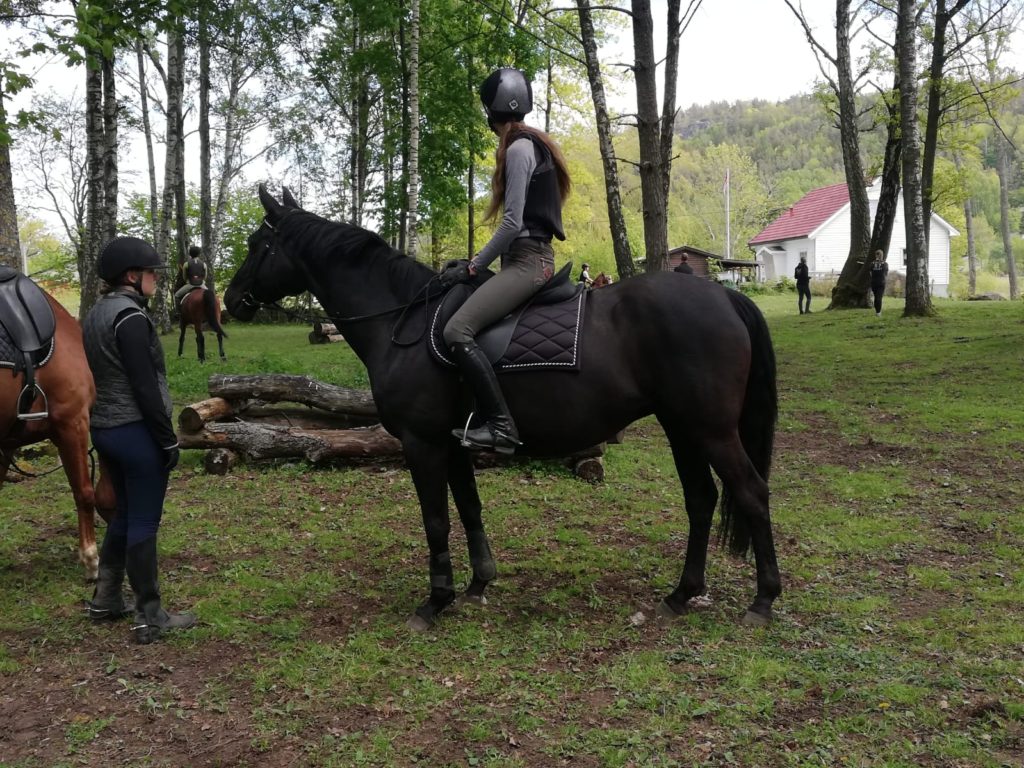
Ellie at her first eventing training in 2020
Bright Gazella (Ellie) is a Danish Warmblood mare, born in 2007. Her father is the Danish stallion Zardin Firfod. And he is by the famous Trakehner stallion Gribaldi. So Ellie is closely related to famous horses such as Painted Black and Totilas.
Her mother’s father is the Elitestallion Aspirant, who was A-stallion in both jumping and dressage in Danmark.
In other words: a pedigree full of top-class performance stallions.
Ellie was sold to a riding school in Norway when she was 5 years old.
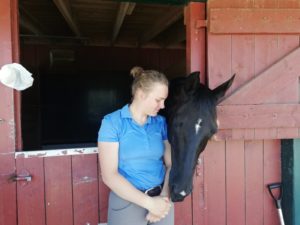
Ellie – friendly, pretty, with big ears – and a very sensitive temperament!
She is a sweet horse, easy to handle, very pretty and not so big (around 1.58).
Extremely sensitive
However…. in spite of her size, she has a very roomy movement.
And she has boundless amounts of energy.
And she is extremely sensitive to anything her rider does.
And she has a HUGE buck when she gets annoyed.
In other words: maybe not the best horse to use in a riding school….
Sent to slaughter
Ellie went lame in a hind leg after only a year and a half of use in the riding school.
The lameness did not respond to treatment. The decision was made to sent her to the slaughterhouse.
We bought her just a few hours before she would have been sent to her death.
Due to various circumstances she has been mostly used for breeding after she came to us.
Since she currently is not in-foal, we have started riding her again. And she is going better and better.
Talent for jumping
Ellie’s breeding is geared more towards dressage. But she surprised us by showing a definite talent for jumping.
This video shows her jumping on the lunge line. She just ‘popped’ easily over everything we built that day. The ‘fence’ here is about 1.10 m high and she jumps it with about 20 centimeters to spare.
Hairline cracks
Like all our horses, she does everything barefoot. Ellie’s hooves are wide and very ‘open’, with a tendency to get underrun heels.
Her hoof quality has never been very good. She is prone to ‘hairline cracks’ on the surface of the hoof wall.
In spite of that, she moves very well and surefooted over almost any terrain. We use hoof boots when riding out over stony roads and tracks.
Note: Ellie’s story reads like a sentimental movie script: the pretty horse that gets rescued and turns out to be a great riding horse. However, reality is not so simple. To take on a ‘free’ rescue horse can mean an enormous investment in time, money, energy – and tears.
In Ellie’s case it meant years of waiting.
Loads of treatments by equine therapists. (And numerous visits to the chiropractor for her riders, every time they got bucked off!)
Trying different saddles, bits, food supplements.
Starting from scratch again under saddle.
All of that without knowing if she ever again could be used as a riding horse…
So if you are considering taking on a rescue horse, our advice is: DON’T.
Or – at least think it over very, very thoroughly.
